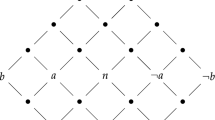Abstract
Most belief change operators in the AGM tradition assume an underlying plausibility ordering over the possible worlds which is transitive and complete. A unifying structure for these operators, based on supplementing the plausibility ordering with a second, guiding, relation over the worlds was presented in Booth et al. (Artif Intell 174:1339–1368, 2010). However it is not always reasonable to assume completeness of the underlying ordering. In this paper we generalise the structure of Booth et al. (Artif Intell 174:1339–1368, 2010) to allow incomparabilities between worlds. We axiomatise the resulting class of belief removal functions, and show that it includes an important family of removal functions based on finite prioritised belief bases.
Similar content being viewed by others
References
Alchourrón, C., Gärdenfors, P., & Makinson, D. (1985). On the logic of theory change: Partial meet contraction and revision functions. Journal of Symbolic Logic, 50(2), 510–530.
Arló Costa, H. (2006). Rationality and value: The epistemological role of indeterminate and agent-dependent values. Philosophical Studies, 128(1), 7–48.
Benferhat, S., Cayrol, C., Dubois, D., Lang, J., & Prade, H. (1993). Inconsistency management and prioritized syntax-based entailment. In Proceedings of IJCAI (pp. 640–647).
Benferhat, S., Lagrue, S., & Papini, O. (2005). Revision of partially ordered information: Axiomatization, semantics and iteration. In Proceedings of IJCAI (pp. 376–381).
Bochman, A. (2001). A logical theory of nonmonotonic inference and belief change. New York: Springer.
Booth, R., Chopra, S., Ghose, A., & Meyer, T. (2005). Belief liberation (and retraction). Studia Logica, 79(1), 47–72.
Booth, R., Chopra, S., Meyer, T., & Ghose, A. (2010). Double preference relations for generalised belief change. Artificial Intelligence, 174, 1339–1368.
Booth, R., & Meyer, T. (2010). Equilibria in social belief removal. Synthese, 177, 97–123.
Brewka, G. (1989). Preferred subtheories: An extended logical framework for default reasoning. In Proceedings of IJCAI (pp. 1043–1048).
Cantwell, J. (1999). Relevant contraction. In Proceedings of the Dutch-German workshop on non-monotonic reasoning (DGNMR’99).
Cantwell, J. (2003). Eligible contraction. Studia Logica, 73, 167–182.
Hansson, S. O. (1991). Belief contraction without recovery. Studia Logica, 50(2), 251–260.
Hansson, S. O. (1993). Changes on disjunctively closed bases. Journal of Logic, Language and Information, 2, 255–284.
Katsuno, H., & Mendelzon, A. O. (1992). Propositional knowledge base revision and minimal change. Artificial Intelligence, 52(3), 263–294.
Kraus, S., Lehmann, D., & Magidor, M. (1991). Nonmonotonic reasoning, preferential models and cumulative logics. Artificial Intelligence, 44, 167–207.
Lehmann, D. (1995). Another perspective on default reasoning. Annals of Mathematics and Artificial Intelligence, 15(1), 61–82.
Levi, I. (1991). The fixation of b elief and its u ndoing. Cambridge: Cambridge University Press.
Maynard-Zhang, P., & Lehmann, D. (2003). Representing and aggregating conflicting beliefs. Journal of Artificial Intelligence Research, 19, 155–203.
Meyer, T., Heidema, J., Labuschagne, W., & Leenen, L. (2002). Systematic withdrawal. Journal of Philosophical Logic, 31(5), 415–443.
Pini, M. S., Rossi, F., Brent Venable, K., & Walsh, T. (2009). Aggregating partially ordered preferences. Journal of Logic and Computation, 19, 475–502.
Rott, H. (1992). Preferential belief change using generalized epistemic entrenchment. Journal of Logic, Language and Information, 1, 45–78.
Rott, H. (2001). Change, choice and inference: A study of belief revision and nonmonotonic reasoning. Oxford: Oxford University Press.
Rott, H., & Pagnucco, M. (1999). Severe withdrawal (and recovery). Journal of Philosophical Logic, 28, 501–547.
Shoham, Y. (1987). A semantical approach to nonmonotic logics. In Proceedings of LICS (pp. 275–279).
Yahi, S., Benferhat, S., Lagrue, S., Sérayet, M., & Papini, O. (2008). A lexicographic inference for partially preordered belief bases. In Proceedings of KR (pp. 507–517).
Author information
Authors and Affiliations
Corresponding author
Rights and permissions
About this article
Cite this article
Booth, R., Meyer, T. & Sombattheera, C. A General Family of Preferential Belief Removal Operators. J Philos Logic 41, 711–733 (2012). https://doi.org/10.1007/s10992-012-9235-5
Received:
Accepted:
Published:
Issue Date:
DOI: https://doi.org/10.1007/s10992-012-9235-5




